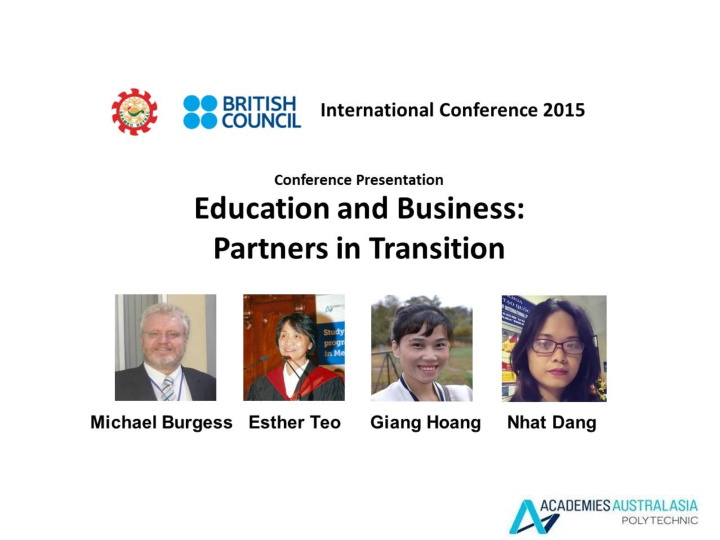



Presentation Outline • Problem Identification • Human Beings • Understanding the present Organisations • Workplace History • The Future • A Multi-generational workplace • Considerations for Educators • Conclusion
A Problem? • Before any action can be taken to solve a problem, we need to recognise that a problem may exist. • How do we see a problem? • Globally? • Nationally? • Locally? • Culturally? • When might be an appropriate time to address the problem?
Human Beings • The human being is the fundamental unit of analysis for the study of: • Humankind; • Management; and • Organisations. • We create reflective educational programs for students towards graduate valuable outcomes.
Human Beings • Humans have a history of transferring knowledge from generation to generation. • Human basic needs and social needs lead to the formation of organisational hierarchies. • People have found advantages in participating and co-operating with each other to achieve goals.
Understanding Organisations • There are many different types of organisations – they differ according to their purpose, but are interlinked: • Business Organisations • Exist for profit • Government Agencies • Implement political decisions • Not-for-profit Organisations • Exist for a social purpose
Understanding Organisations • Special Interest Groups • Unions, business groups, social movements. • Cultural Institutions • Create, preserve and transmit beliefs and values: • Media; • Education; • Religious; • Sport.
The 19 th Century Workplace
The early 20 th Century Workplace
The Workplace Today
Weber’s Principles • Rational-legal Authority • Specialisation of Labour • Hierarchical Structure • Co-ordination and control through rules and standard operating procedures • Standardisation employment practices • Separation of jobs and people • Formalisation of administrative acts, Max Weber 1864 - 1920 decisions and rules
The Future Workplace
A Multi-generational Workplace • In the relatively near future, five generations working side by side: • Those born prior to 1946; • Those born between 1946 and 1964; • Those born between 1965 and 1976; • Those born between 1977 and 1997; and • Those born after 1997.
Recruitment for this new Workplace World? • What does this mean for education towards creating workplace engagement across multiple generations? • ‘Every employee will have a leadership score’: • Based on ratings using social media and other input (Gary Hamel) • Reputational Capital: • For hiring and promotion; • Education and experience. • Diversity & relationships will be a business issue. • Rather than a human resource issue.
Workplace Relationships Drawn from: Mayer, R.C., and Schoorman, D. (1998) ‘Differentiating Antecedents of Organisational Commitment: a test of March and Simon's Model’, Journal of Organisational Behaviour , 19, 12-28
Understanding the Problem • Resources and capabilities are the primary sources of business profitability. • Organisations are complex systems. • Considerations: • Identity; • Information; • Relationships.
A Possible Framework
Business Courses Today • Business courses rely on teaching the concepts of: • Conceptually scanning the various landscape environments; • Acknowledging the depth of analysis of the scan; and • Considering forms of organisational strategy response that is functionally integrative. • Examinations are then directed at the practical application of such analysis in a business setting.
The 2020 Employee • An employee in the 2020 workplace may: • Be born in one country; • Be educated in another; • Work in a third; and • Be on-line studying in a fourth. • We cannot make the usual artificial distinctions: • (e.g. those born 1946-1954 may have certain definable characteristics, those born 1977-1997 may have others).
Considerations for Educators • The present business educational way, is to create understandings about: • Strategy; • Economies of Scale; • Economies of Utilisation; • Control systems; • Processes and functions etc., • The critical issue: • Intensity of activity co-ordination.
Considerations for Educators • Organisation: • The internal logic and workings of arrangements; • Traditions; • Inheritances; and • How people pursue their own interests and goals. • A further necessary consideration for the new Workplace: • Intensity of co-ordination will depend on the intensity of co-operation.
Considerations for Educators • Integration and Consistency: • Towards defeating organisational cultures that may be independent and even in conflict with each other. • Behaviours are Functional in Nature: • Constraints and influences; and • Emotions and moods. • Unaddressed, can create direct costs and consequences. • A web of relationships.
Considerations for Educators • Business courses should be enhanced: • We need a strategic re-orientation of thinking; • From educating what ‘is’ - towards ‘what will be’ ; • Moving away from the generalised analysis and solution approach. • The World Values Survey suggests that mass values between people of different countries are not converging. • Perhaps we are not all becoming international ‘organisational soldiers’. Drawn from World Values Survey, URL = http://www.worldvaluessurvey.org/WVSContents.jsp
Considerations for Educators • Devising course subjects requires: • An acknowledgement of employee participation at the behavioural level, as well as the business level. • Towards the creation of graduate attributes: • Business intelligence (existing); and • Emotional intelligence (new). • An acknowledgement of the changing dimension. • An effective tool to also help cope with change.
Conclusion • Our educational challenge: • We need a change in business learning, if we are to achieve necessary graduate outcomes towards the new Workplace World; • A revised educational framework that is similar, yet different to the existing; and • A steered engagement towards agreed priorities. • Education and Business working together to make the transition.
Thank You!
Recommend
More recommend